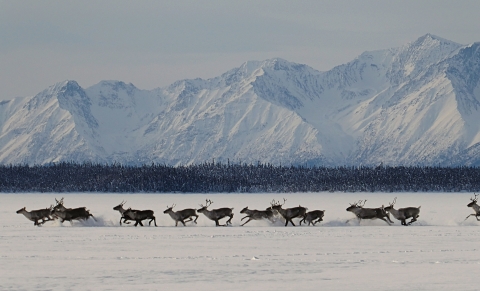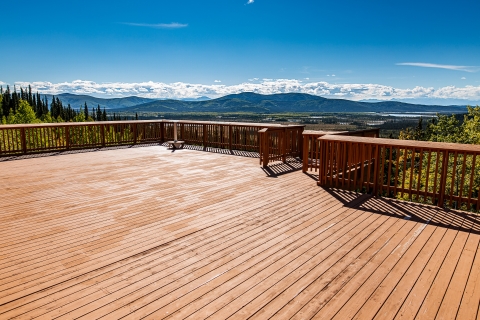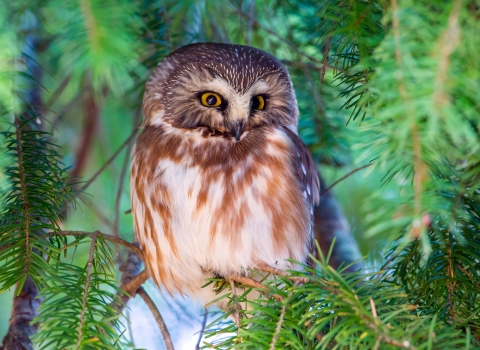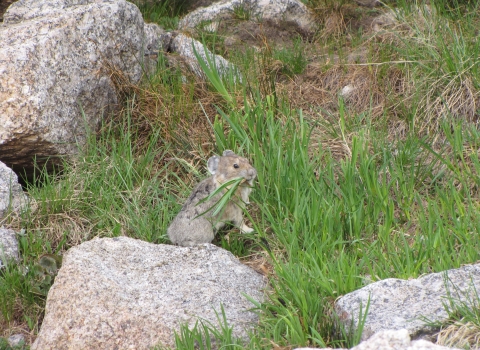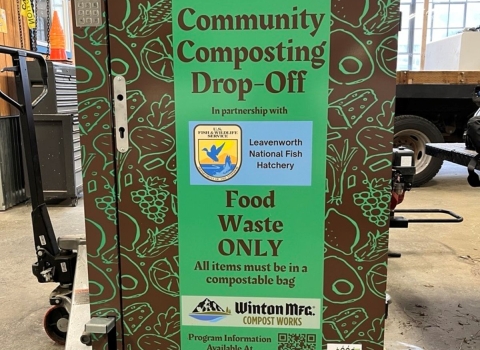Early life for Cora Demit was defined by family and fish: two concepts that may seem disparate, but in Cora’s case they combined to create the foundation for a joyous childhood.
“I was born in Northway south of Tok, but my four siblings and I grew up in a fish camp,” recalls Cora, an Upper Tanana Athabascan tribal member. “It was on an allotment my mother owned, about 20 miles from the village. My father died when I was three years old, so my mother and grandmother raised us. And that camp was our world.”
Only one other family — friends of Cora’s mother — lived on the allotment. Everyone toiled endlessly from late spring through early fall, harvesting whitefish, pike and suckers from adjacent waterways, drying the fish on racks, trapping and hunting.
“It was true subsistence living,” recalls Cora. “Over the course of a season, we could literally put up tons of fish, and we also had meat from caribou and moose, and blueberries and cranberries. For storage, we’d build caches or dig pits in the ground down to permafrost, and my mother would arrange the food between layers of willows.”
The family was poor in the sense that there was little available cash, says Cora, “but the land provided for us, just as it had provided for our ancestors over thousands of years. We didn’t have toys — for Christmas, our presents were moccasins and mukluks my mother sewed from moose skins she had tanned. But we had everything we needed, and I was so happy there.”
But though the fish camp formed the physical parameters of Cora’s life, her mother knew the family — indeed, all Upper Tanana Athabascan people — straddled two worlds. And the outside world was encroaching on the traditional world Cora knew. From mid-autumn through early spring — when she wasn’t at fish camp — Cora attended a Bureau of Indian Affairs school in Northway. And when she was around ten, her mother sent her to a boarding school in Wrangell.
“My mother couldn’t read or write, and she felt that we needed to get formal educations to negotiate the modern world,” says Cora. “But I didn’t want to leave her. They put me on a little plane at Northway kicking and screaming, and I kicked and screamed when they transferred me to other planes at Fairbanks and Juneau. I was incredibly homesick — traumatized, really. Even today, more than 50 years later, I sometimes get a little twinge when I’m on a plane because that memory comes back.”
The following years were tough for Cora. In the 1960s, Alaska Native children were punished for speaking their primary languages in school, and tribal cultures were denigrated.
“I wasn’t allowed to speak Upper Tanana Athabascan, and they cut my long hair,” recalls Cora. “My mother was terribly upset when she found out. In general, Native kids were just treated poorly. I wanted to come home, but mom wouldn’t let me, insisting that I needed to be educated. She’d send me dried fish and meat to make me feel better.”
Ultimately, says Cora, “I just went within myself for protection, and I stayed there.”
Things started to turn around after Cora graduated high school. A school counselor, Dorothy Johnson, took the young girl under her wing and helped her find work. The genuine concern and care expressed by her mentor was transformational, Cora says — she describes herself as a butterfly emerging from its chrysalis.
“Dorothy made me feel worthy again,” Cora says, “and when I returned to Northway I got a job at the airport lodge, doing everything from waitressing to cleaning rooms. And I did the best job that I could possibly do. My mother taught me that. There’s a saying in our language, which essentially translates as ‘Do the best you know how,’ no matter what it is. That ethic kept us alive in our family fish camp, and that’s still how I live my life today.”
Cora married her husband, Glenn Demit, in 1966, and they eventually had four children. She became an alcoholism counselor and still maintains her certification “because sometimes people just want to talk. Sometimes they need to call and check in, and I always want to be available to help.”
Later, she became a special education aide for the Northway school district.
“I had that position for 10 years and I loved every minute of it,” says Cora. “Working with those kids was one of the most rewarding things I’ve ever done.”
Cora’s life changed again in 1991, when the U.S. Fish and Wildlife Service posted an opening for a Park Ranger at the Tetlin National Wildlife Refuge. She applied for the job and got it, and later became a Refuge Information Technician, charged with overseeing Tetlin’s visitor center in Tok.
“It keeps me really busy from spring through fall,” Cora says. “I work on everything from our budget to refuge statistics, but public contact and outreach is a big part of the job. Tok and Tetlin are the first places most people visit after crossing the Canadian border on the Alaska Highway, and I’m often the first face they see. I take that very seriously. I want to make sure they have a good impression of Alaska and Alaskans.”
Debbie Steen, the Chief of Visitors Services and Communications for U.S. Fish and Wildlife Alaska, says Cora invests her position with particular meaning due to both her native heritage and her personal qualities.
“When she welcomes people, she welcomes them not only to Alaska, not only to the Tetlin National Wildlife Refuge, but to her homeland, to the place where her ancestors lived for thousands of years,” says Debbie. “She loves Tetlin — the land, the habitats, the wildlife, the people — and she’s able to communicate that. She also spends a great deal of time just helping people out, including traveling to Fairbanks and Anchorage to visit elders and other community members who are in the hospital.”
Upper Tanana Athabascan culture remains the central anchor to Cora’s life. She still speaks — and thinks — in her native language, and is teaching it to younger tribal members to ensure it remains a vital and living tongue. She still makes moccasins and mukluks from traditionally tanned hides, which she decorates with extensive and meticulous beadwork. And she still savors the traditional foods of her childhood.
“I couldn’t get along without my fish and moose meat,” Cora says. “When I eat them, I’m taken back to our fish camp, to the place where I was happiest as a child. Food and language are the bedrocks of our culture. Without both, I’d be lost.”
When did you join the U.S. Fish and Wildlife Service?
1991
What do people find most surprising about your job?
Sometimes vendors to the visitor center seem surprised that a native person is in charge. Also, I think some people are surprised that I always smile, no matter the circumstances. I consider that part of my job — you have to smile whether you want to or not. You have to demonstrate that you’re a good ambassador for the Service, the refuge, the State of Alaska and Alaskan Native people.
How do Alaska’s wild places sustain you?
It’s the sheer beauty of Alaska — the scenery, the wildlife, the bird migrations. So much of this state is still untouched. Also, there’s no smog. You can breathe here.
What’s your foremost concern about Alaska’s wildlife resources?
Preserving our wildlife habitat — because that’s how we preserve wildlife. It can be a challenge. Also, I’m really disturbed when people just want to only kill wildlife, or kill an animal for a trophy and leave the meat. There’s no excuse for that. A lot of people, including native people, would love to have that meat. If you kill an animal, you have to consume or share the meat.
When I’m not at work, I’m…
…Visiting elders, traveling, doing my beading projects — just staying connected to the community and life. My mother and grandmother always said, “Do for others.” That means if someone down the street needs help, go help. Don’t ask. Just do it. I still follow that advice.
What’s the greatest misconception people have about Alaska?
That we have wildlife running around in our backyards. Many visitors expect to see a lot of animals right away. It’s not like that at all.
What’s your most treasured memory about Alaska?
The people I meet at my job provide some of my best memories. I really look forward to going back to work in the spring, to meeting all the new people. I love sharing my culture and the wonders of this state with our visitors.
What advice would you give to people interested in working for the U.S. Fish and Wildlife Service?
Get some cross-cultural training. That’s especially important if you want to work in Alaska. Too many misconceptions remain about Alaskan Native people, and it’s important that we educate people.
What animal particularly inspires you?
Probably moose. Moose meat was central to my survival growing up, and it’s still very important to me. They’re amazing animals.
In Alaska we are shared stewards of world renowned natural resources and our nation’s last true wild places. Our hope is that each generation has the opportunity to live with, live from, discover and enjoy the wildness of this awe-inspiring land and the people who love and depend on it. For this story and more like it follow us on Medium.

